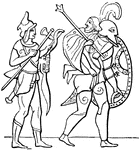Clipart tagged: ‘Sceptrum’

Sceptrum
"Sceptrum, which originally denoted a simple staff or walking stick, was emblematic of station and authority.…

"Sceptrum, which originally denoted a simple staff or walking stick, was emblematic of station and authority.…